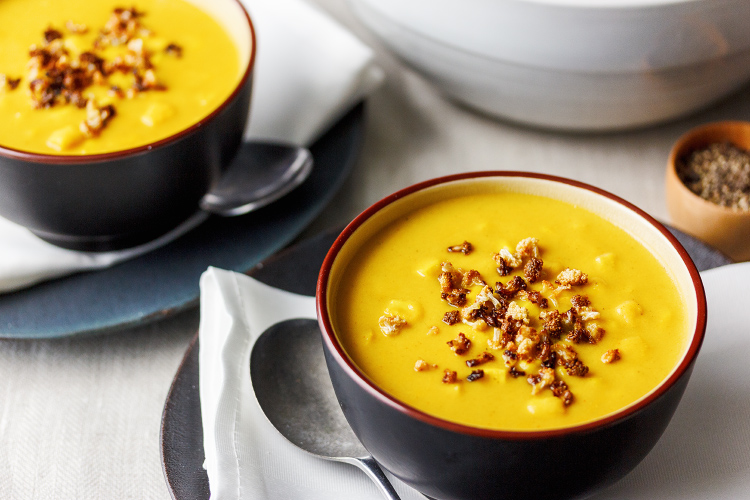Corn chowder
Velvety smooth (and dairy-free) with crunch from teeny tiny roasted cauliflower nubbins.
The way I make my corn chowder has evolved over the years to the point where I don't think it technically qualifies as a chowder any more. But we live in a time when words like "news" and "personality" mean very much less than they used to, so I forgive myself when it comes to soup.
Instead of adding cream, traditional in a chowder, I now rely on the ingredients themselves to provide a creamy texture. Most of the work is done by the small amount of potato, cooked along with half the corn. Everything gets blended, which makes the soup smooth, obviously, and thickens it in the process. Then, because completely smooth soup can feel a bit like convalescent food, I add more whole corn kernels for texture.
Cook's tip: Use the corn which is most convenient for you: fresh, frozen or canned. To make life easier, you should know that the drained weight of a 400g (14 oz) can of corn will be about 250g (9 oz).
To ramp up both the colour and flavour I use turmeric and paprika, and the glowingly golden result can bring a little sunshine into a cold and dreary day.
While it’s easy to make to be served straight away, it also reheats very well, so making it to be eaten later in the day – or even later in the week – only adds to its charms.
I top my corn chowder with a sprinkling of tiny roasted cauliflower florets, and the way to make them follows. Otherwise, depending on your dietary preferences and adherence to tradition, bacon bits, sour cream or some grated cheddar cheese are always safe bets, although it is perfectly good – more than good – ungarnished and uncluttered, just the way it is.
Corn chowder
Serves 2.
1 tablespoon olive oil
1 medium onion
1 teaspoon paprika
½ teaspoon turmeric
250g (9 oz) corn kernels
500ml (2 cups) vegetable stock
150g (5 oz) potato, diced
sea salt flakes
freshly ground black pepper
Warm the olive oil in a heavy-based pan over medium heat. halved and sliced
Cook the onion slowly until it becomes soft and translucent, then stir in the paprika and turmeric. Season lightly with salt and pepper.
Add half the corn and all the potato and vegetable stock. Bring up to a bubble then turn the heat down, simmering for 30 minutes. The potato should be very tender, on the verge of falling apart.
Blend the soup in batches – carefully, please: hot blenders explode – and return to the pan. (If you have an immersion or stick blender, you can do this directly in the pan.) You can make the soup silky smooth by pushing it through a chinois or other fine sieve at this point if you like, but this is not an essential step.
Once the soup returns to a lively simmer, add the remaining corn kernels and cook for 10 minutes.
Taste for salt and pepper and season as required.
Roasted cauliflower nubbins
Because these will keep for a few days, I make them whenever I find a small piece of cauliflower lurking in the crisper drawer. Beside their use with the recipe above, they're also handy to scatter into salads and sandwiches for some instant crunch and flavour. This is more of a technique than a strict recipe, so make as many as you need.
Set your oven to 200°C (400°F).
With a small knife, cut the very end tips from the tops of a piece of cauliflower. If you cut right at the end of the stems, you will be able to carefully separate the cauliflower into small pieces, each of which is a tiny floret in its own right. (It's cauliflower Inception.) Place them in a small bowl.
Add a few drops of olive oil and toss very gently with a teaspoon to avoid breaking them up. You want them to be just coated with olive oil, so add a little bit at a time.
Put the cauliflower on a baking sheet lined with baking paper and roast for about 10 minutes. Watch them like a hawk, however, as they can go from golden brown to black very, very quickly. Check regularly from around the 7-minute mark and don't leave them for a second!
Once they've coloured up nicely, remove from the oven and let them cool on the tray for a few minutes, then carefully transfer them to some pieces of kitchen towel to blot the excess oil. Let them dry out and crisp up on the paper for half an hour, then keep them in an airtight container until needed.


